
Material: Wood
Dimensions: 17cm h.
Provenance: Private Collection, UK
Notes: Fine and old central Congo headrest, with deep patina and incised parallel line decocration to the curved support and pyramid base. Compare with the Bryce Holcombe bequest in the MET (Accession Number: 1986.478.8). Also Oldman Collection in the British Museum (no. 1949 Af46.580) identified as ‘BaLuba’. Also the Rev. James Moon Collection in the National Museums of Scotland, for a headrest identified as 'Mongo' collected pre-1916.
Price: POA

AF47
Material: Wood
Dimensions: 35cm
Provenance: Bonhams
Notes: In order to make the drudgery of agricultural labour more interesting Senufo run physical competitions for young farmers. The first to finish digging a trench is crowned as champion cultivator (sambali), the 'master farmer'. He is awarded a tefalipitya staff. It represents pitya, a young, unmarried, and beautiful woman, and is a symbol a future marriage. It is the highest honour for a Senufo man to be known as sambali, a title that stays with him until his death, upon which his tefalipitya staff is placed outside is home to guard his spirit.
Price: POA
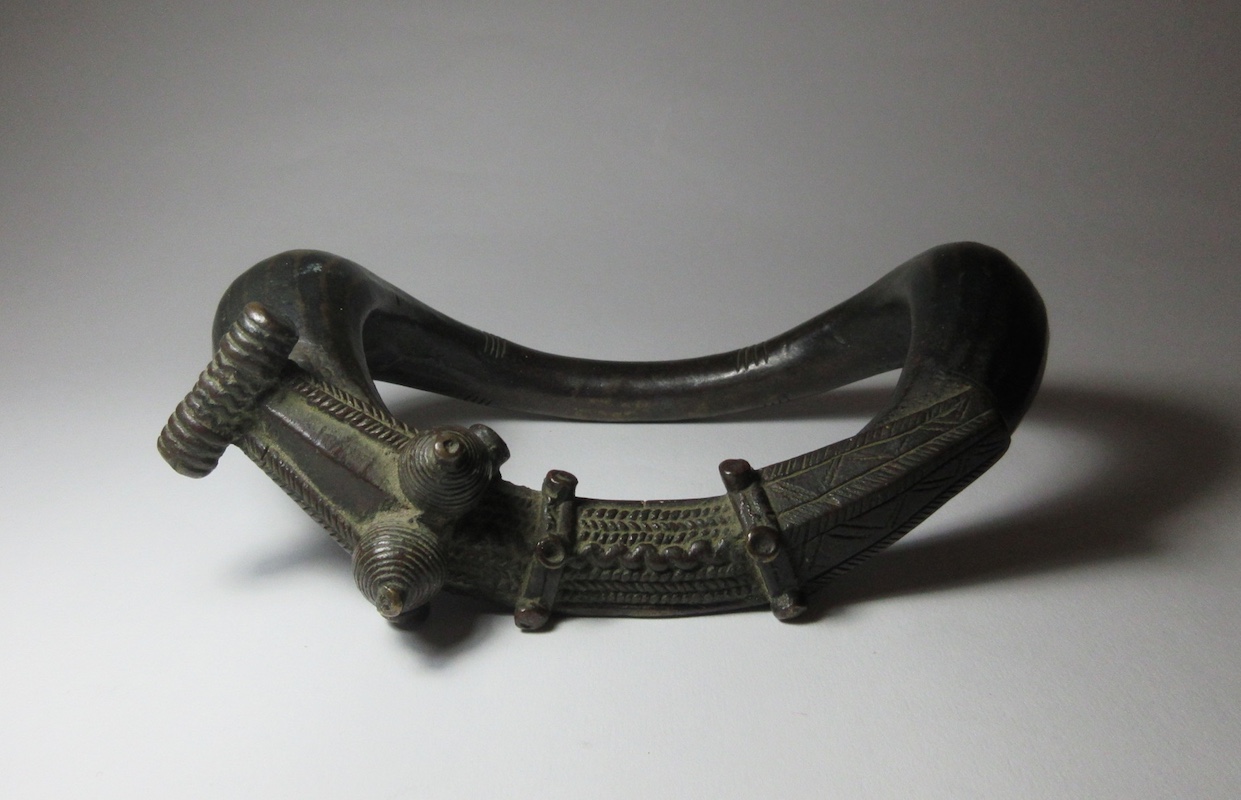
AF9
Material: Bronze
Dimensions: 15cm
Provenance: Phillips, London
Price: POA
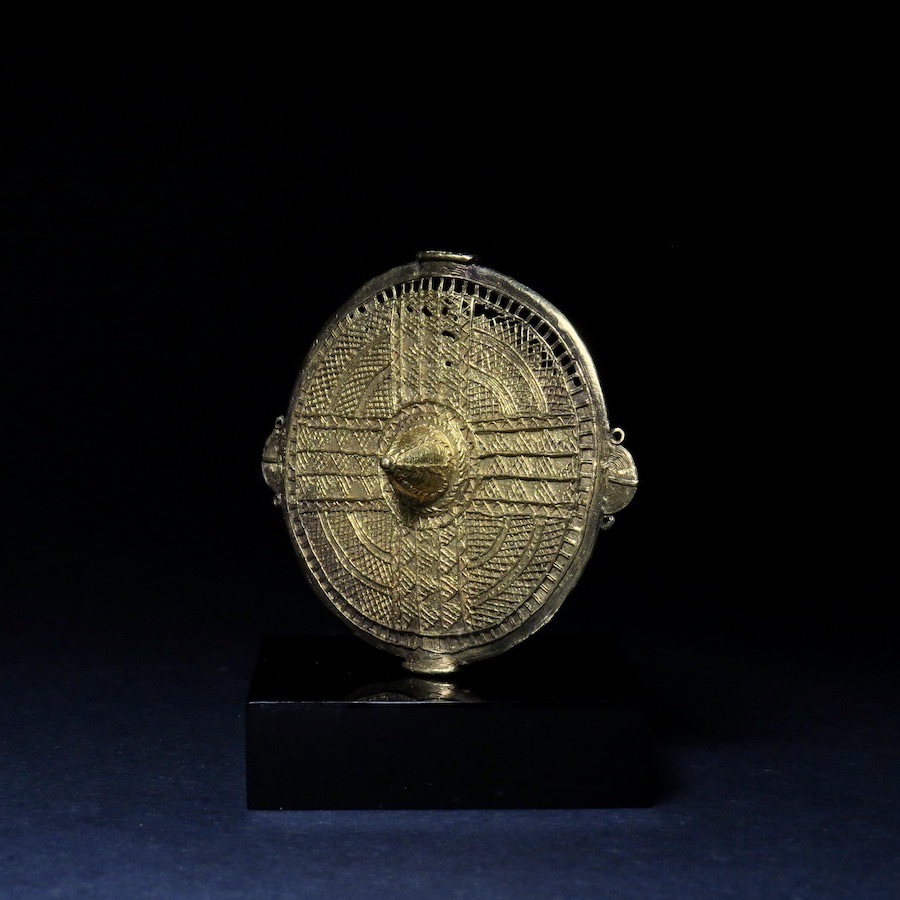
AS149
Material: gilded metal
Dimensions: 7cm diam.
Provenance: Deceased estate, UK.
Notes: In Akan thought, gold is considered an earthly counterpart to the sun and the physical manifestation of life's vital force, or kra. Cast gold and gilt metal disks called akrafokonmu ("soul washer's disc") are worn as protective emblems by important members of the court, including royal attendants known as akrafo, or "soul washers." Individuals selected for this title are beautiful young men and women born on the same day of the week as the king. Worthy of serving the king in light of their youth and vigor, they ritually purify and replenish the king's vital powers and, in doing so, help to stabilize and protect the nation. This akrafokonmu displays a central conical rosette surrounded by concentric bands and a cross motif. The composition as a whole reflects specifically Akan aesthetic concepts, in that the circular form of the disc and the concentric arrangement of the designs evoke the emanating rays of the sun that were the source of the kra of the king and his people.
Price: POA
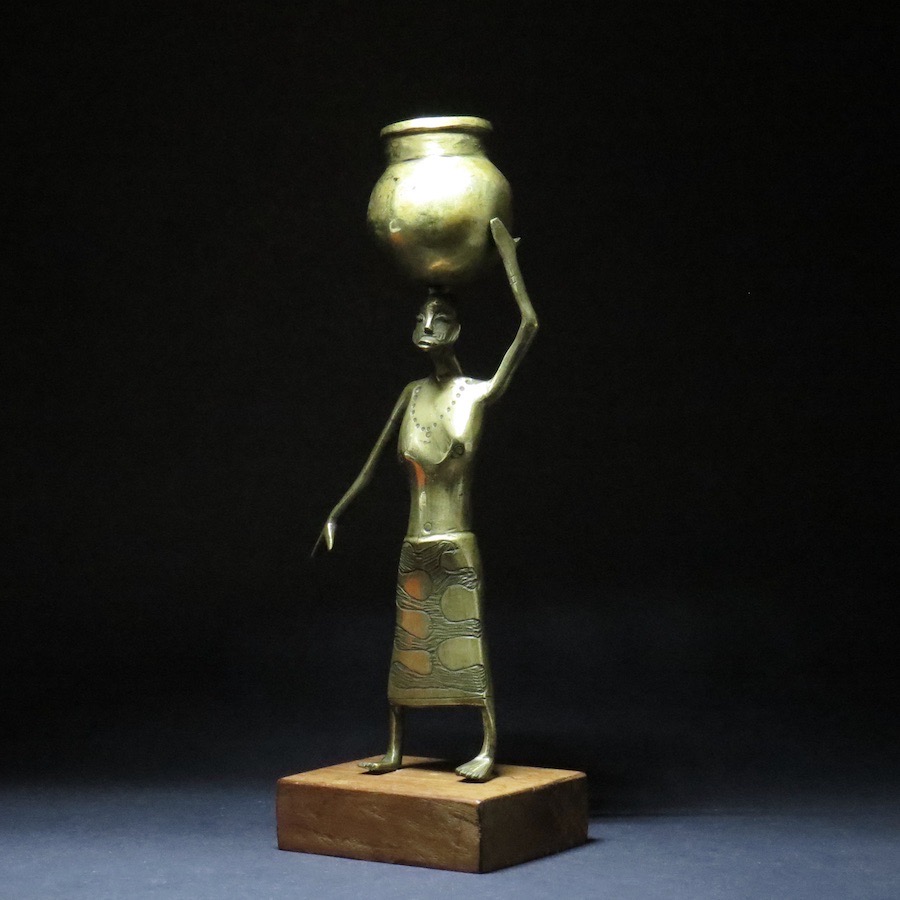
AF146
Material: gilt brass
Dimensions: 21.5cm high
Provenance: Deceased estate, UK
Notes: Brass is considered a semi precious metal amongst the Fon, and figurative castings depicting rural life or illustrating proverbs, are displayed in homes as art objects and to reinforce social status. Price: £495

AF144
Material: wood, raffia
Dimensions: 27 x 36 x 30cm
Provenance: Private Collection UK
Notes/Literature: The tri-lobed coiffure carved beneath an elaborate woven geometric cut-pile raffia headpiece with side flanges. Striking protuberant conical eyes, with pierced perimiters for sight above a large angular nose and diminutive smiling mouth, all painted overall with brown and white geometric and dotted patterns. Pwoom itok represents a wise old man and is performed at initiations and burials to signify elders’ knowledge. The mask wears the U-shaped raffia headdress of a high-ranking male warrior. Originally it may have been crested with a bunch of speckled feathers representing high titleholders. Instead there is a little domed raffia cap of a titled male called laket.
Price: POA
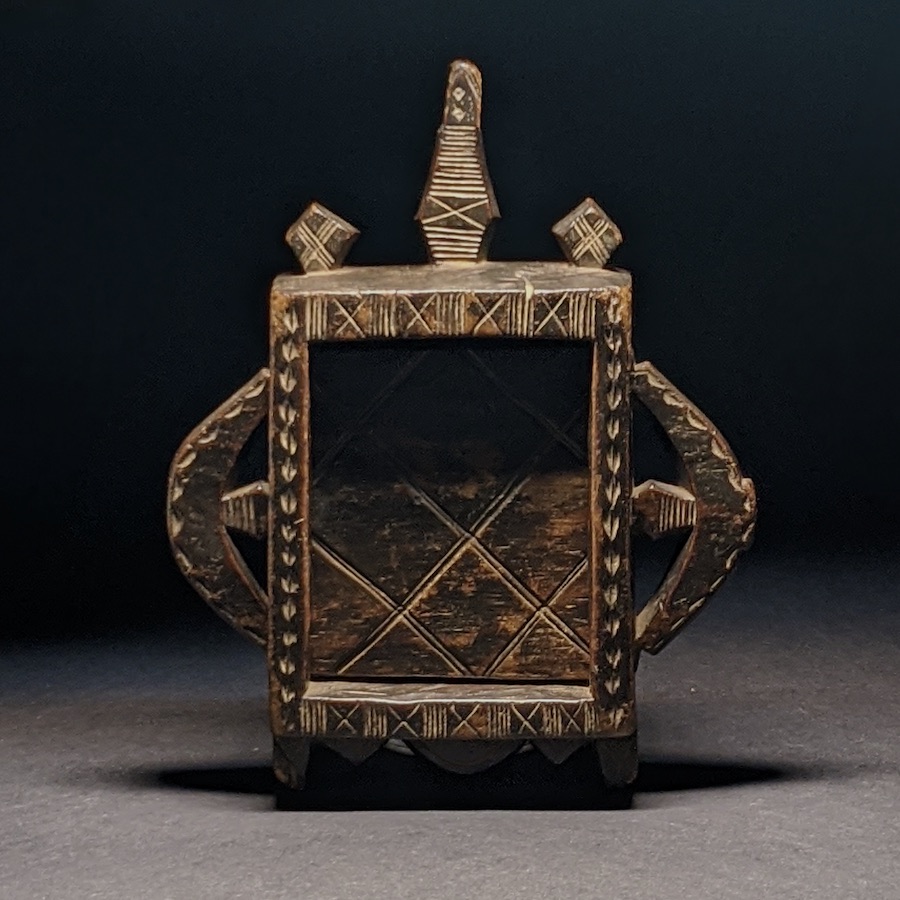
AF71
Material: Wood, glass, paper.
Dimensions: 22 x 18 x 5cm
Provenance: Private Collection, UK
Literature/Notes: Cosmetics boxes or vanity cases are found amongst numerous groups in Nigeria, including the Yoruba and Igala, but rarely the Nupe. This box is modelled as a stylised turtle with the cover as a koranic tablet which slides open to reveal a mirror of sorts, composed of glass and silvered paper. The vertical borders are carved with stylised cowrie shells, whilst the head, limbs, cover and sides are incised with parallel lines or crosses. The back is domed like the turtle's carapace, and incised with geometric motifs allover. Similar stylised turtles can be found amongst other animal and domestic motifs on Nupe palace doors famously carved in Sakiwa's compound at Lapai.
Price: £550

AF140
Material: wood, raffia, pigment
Dimensions: 30 x 27cm (mask only)
Provenance: Private collection, UK.
Literature/Notes: Ibibio inhabit the area between the Cross River and the Niger Delta. This mask has an articulated jaw bearing teeth, and retains orange pigment about the eyes and a large part of its black dyed raffia fringe and beard. Cf. Herbert M. Cole, Invention and Tradition: The Art of Southeastern Nigeria, Prestel, 2012, p. 75, "Ekpo - the Ibibio word for ancestor - members danced light coloured ‘mfro’ and black or dark coloured ‘idiok’ masks that evoke benign and more numerous malevolent ancestors, respectively. Ancestors are responsible for advising and protecting their living descendants. The masks partake of the Beauty/Beast modes discussed above, even if some of the dark, large-featured masks have a benign role in social control." Compare with an Ibibio mask with articulated jaw in the National Museum of African Art (Smithsonian), no. 97-8-1.
Price: POA

Material: wood
Dimensions: 37cm H
Provenance: Private collection, UK. Bonhams.
Literature/Notes: The Igala live south of the Benue River and east of the Niger, and are closely related to the Jukun and Chamba with whom they share many artistic traditions. Figures carved in the Akpa region of Igala country, have characteristic crest coiffures, flat oval faces and angled cheek scarifications. This figure has a rod beneath the platform base. One arm broken.
Price: POA

AF4
Material: wood, sacrificial material, bespoke stand
Dimensions: 37cm H
Provenance: Max Wilborg; Private Collection, UK
Literature: The Wurkun are well known for their male/female figures mounted on spikes used to ensure the well-being of the family through the fertility of crops. They were installed in the fields beside conical grass structures. Others were placed on domestic shrines and used for curing illness or divination. This figure has fine encrusted surface patina. Cf. Alisa LaGamma, Echoing Images - Couples in African sculpture, 2004 for a discussion of kundul and other pairs of figures. According to Joerg Adelberger, 'Kundul and other wood sculptures are produced by carvers who are often blacksmiths (as we might anticipate given the presence of the metal spikes). Typically, they are made on the directive of a priest who will tell a person seeking his help to procure such a sculpture for further use in ritual treatment. Comparison with Mumuye figures, especially in profile, suggests that the "arms" of Wurkun figures might be construed stylistically as an abstract development of the bent arms of the Mumuye figures. Together with the protruding umbilicus, these features might indicate a connection between Mumuye and Wurkun, especially in the light of the claim by a Kulung clan to have originated from the Mumuye area.' (Berns, Marla, Richard Fardon and Sidney Littlefield Kasfir (Eds.), Central Nigeria Unmasked: Arts of the Benue River Valley, Fowler Museum at UCLA, 2011, p. 428)
Price: POA
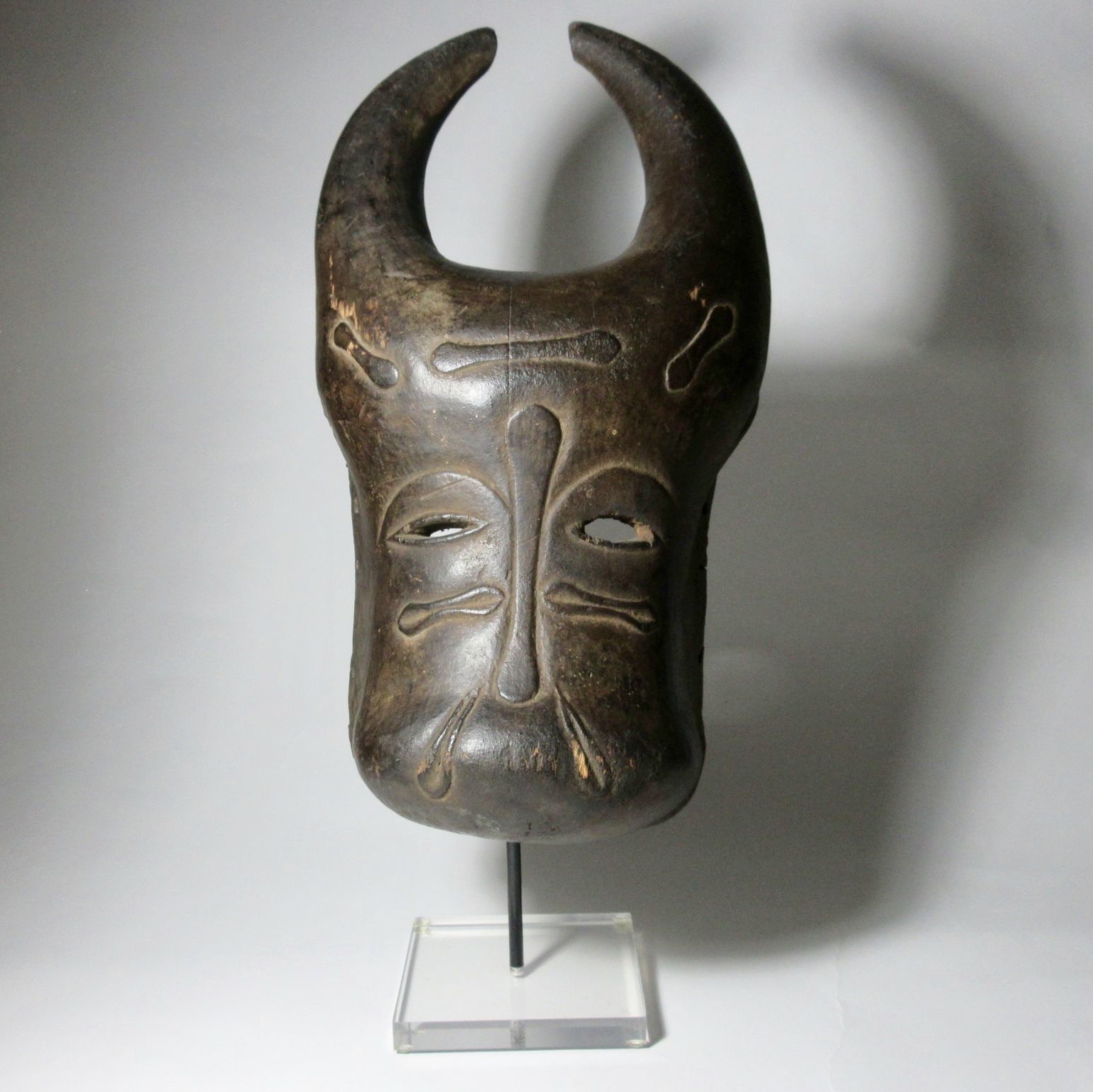
AF32
Material: wood
Dimensions: 23cm
Provenance: Private Collection, UK
Literature/Notes: Domestic and wild animal masks are danced as part of the Gbagba performances amongst the Baule in a series of amusing skits that represent a microcosm of the human world. They are performed to mock and poke fun at stereotypes and usually draw a moral. This mask represents the bush cow, and shows signs of considerable age. It is sensitively carved with with gentle rounded volumes and has a deep brown patina.
Price: POA

AF67
Material: wood
Dimensions: 36 x 22 x 18cm
Provenance: Leendert Van Lier, Netherlands
Literature/Notes: This rare mask is particularly elaborate for its type. The features are carved in high relief with bold colouring. The coiffure is ornamented with a two-tone human head and four medicine bottles. The white eyes and teeth vividly contrast against the dark face with details picked out in red-brown. Old label behind. These masks were worn by members of the Ekpo, a male society that manages the welfare of the village and settles disputes and depict ancestors. The Ekpo also have traditionally performed rituals related to planting, the yam harvest, and funerals. Compare this with a Binio Ekpo mask with carved figure and medicine bottles on the forehead formerly in the William Brill Collection, published in Werner Gillon, Collecting African Art, 1979, p. 72, ill. 70.
Price: POA

AF43
Material: wood
Dimensions: 80cm
Provenance: Private Collection, UK
Literature/Notes: Sculpture, music and dance generally express the symbols of royal power, such as the bush cow.
Price: POA

AF118
Material: Wood
Dimensions: 16.5 x 12 x 7cm
Provenance Max Wilborg. Private collection
Notes Ugly masks, in contrast to beautiful/good masks, exhibit exaggerated and distorted features representing malevolent, wandering spirits of ancestors (idiok ekpo). They are usually small, with non-human features such as jagged teeth, painted black and sometimes represent the disfiguring disease gangosa (Rhinopharyngitis mutilans, which attacks the soft tissue of the nose and palate), and is called odok (no-nose) in Ibibio.
Price: POA
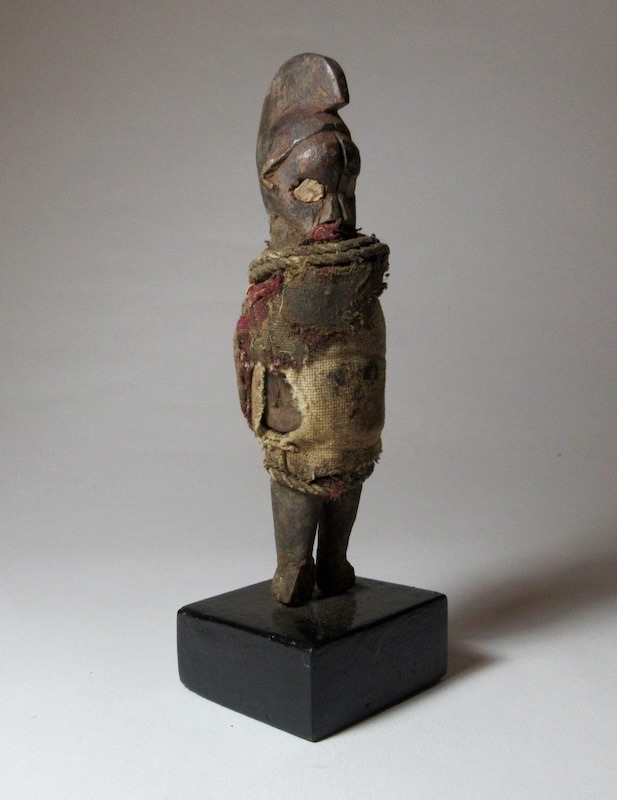
AF33
Material: wood, shell, cloth, string
Dimensions: 12cm H.
Provenance: Max Wilborg, London (collection no. 732020)
Price: £850
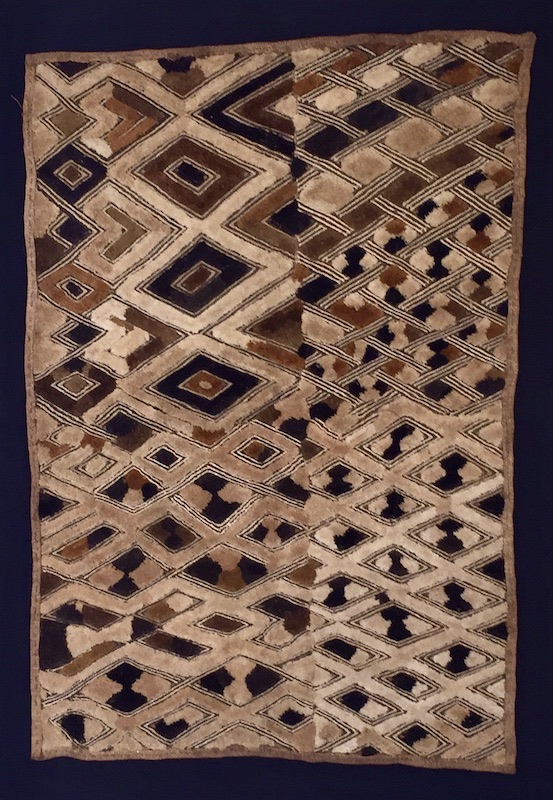
AF111
Material: raffia
Dimensions: 45 x 26cm
Provenance: Bonhams London
Notes/Literature: The Bushoong, Ngongo and Shoowa subgroups are known for producing complicated woven and dyed raffia textiles, for a variety of purposes. Nbol (colloquially known as 'Kasai Velvets') involve both embroidery and cut pile techniques, using named interlocking geometric designs replicated in Kuba wood carving and body scarification. They were used for dowry payments, as seat mats, floor mats and as shrouds. Cf. John Picton & John Mack, African Textiles, 1989, p.200. Also John Mack, Emile Torday and the Art of the Congo 2900-1909.
Price: £270

AF6
Material: wood
Dimensions: 13 x 2.5 x 2.5cm
Provenance: Private Collection
Literature: William Fagg, Miniature Wood Carvings of Africa, 1970, p. 88, figs 84-85. Small figures such as these, were sometimes worn around the neck of infants and were used as protective charms.
Price: POA

AF2
Material: wood
Dimensions: 45cm
Provenance: John Christopherson (1921-1996). Phillips, London.
Literature, Notes: Representing a Bush Spirit or Spirit Wife, this powerful seated female is modelled suckling a child in her ams, whilst seated on a stool. Remains of fibre to rear coiffure and blue pigment to neck keloids. Cf. figure in the Seattle Art Museum, published in Praise Poems - The Catherine White Collection, 1984, p. 42-43, fig. 17 for a similar seated maternity. Also see a mask formerly in the Rudolf et Leonore Blum Collection, sold Christies, Paris 19.6.2014
Price: POA
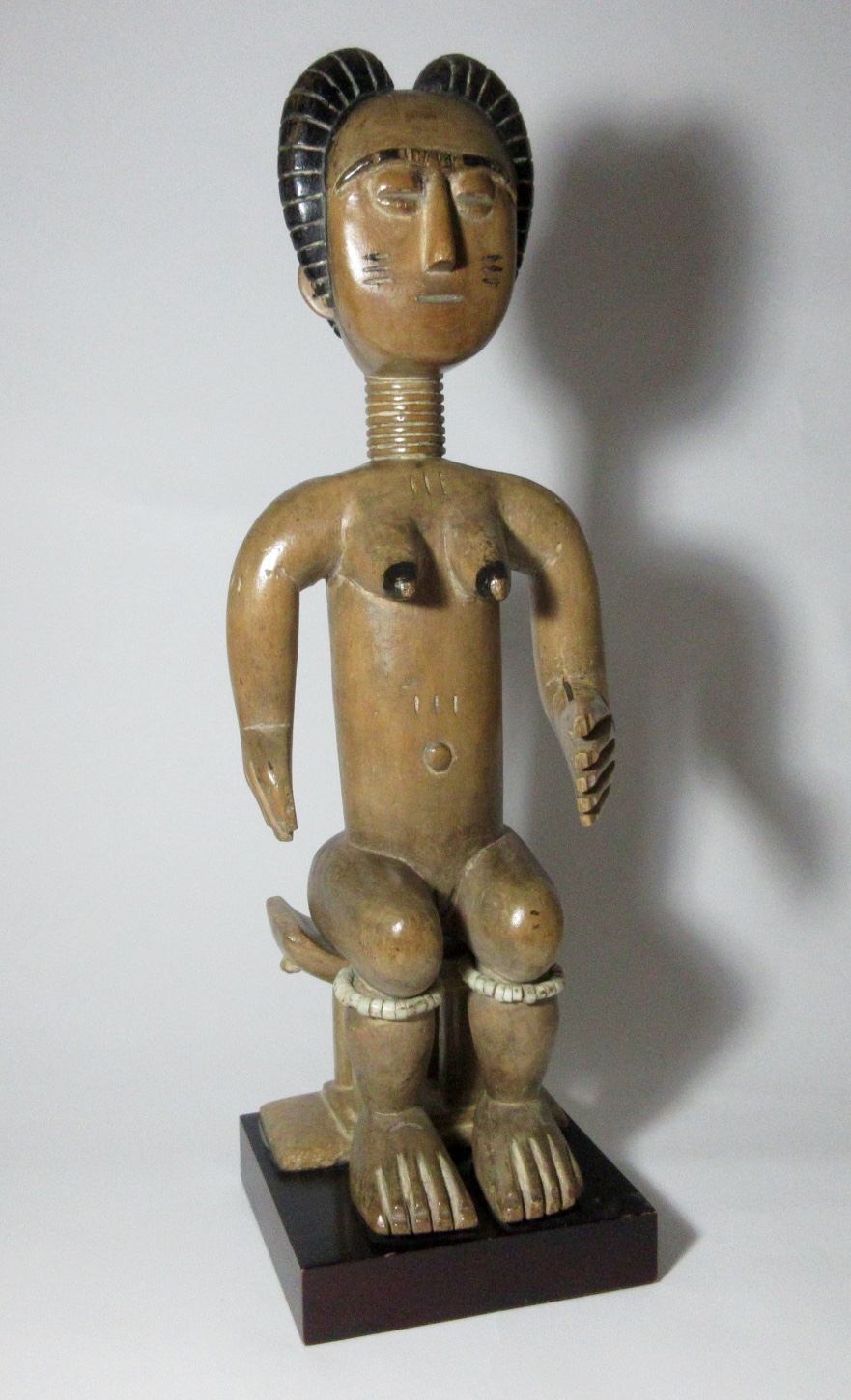
AF8
Material: wood (arm restored)
Dimensions: 40cm
Provenance: Boisgirard, Paris.
Literature/Notes: Figures like these are used as an aid to conception by a priest who invokes the influence of his cult deity to induce pregnancy. The flat forehead is a convention of the Akan ideal of beauty. Figures are used during pregnancy too, to ensure safe delivery. Cf. Monni Adams, Designs For Living, p. 50, fig, 26, for a standing female almost certainly by the same hand/studio in the Mary Ellen Alonso collection. Also see H. Cole and D. Ross, The Arts of Ghana, 1977.
Price: POA

AF35
Material: wood
Dimensions: 80cm
Provenance: Ex. Prof. Ferdinand Herrmann Collection, Germany
Literature/Notes: Palm wine gourds, covered with coloured bead sheaths, were raised on stools and formed part of the Royal regalia displayed on important occasions. This version, carved in wood in the shape of a natural gourd, and ornamented with panels of cowrie shells, is also supported by an elephant, itself a symbol of power and Royal authority and reserved exclusively for the king. Compare with the Wield Bamileke stool with similar cowrie shell carved frieze in Karl-Ferdinand Schaedler, Gods Spirits Ancestors, 1992/3, p. 166, ill 133.
Price: POA
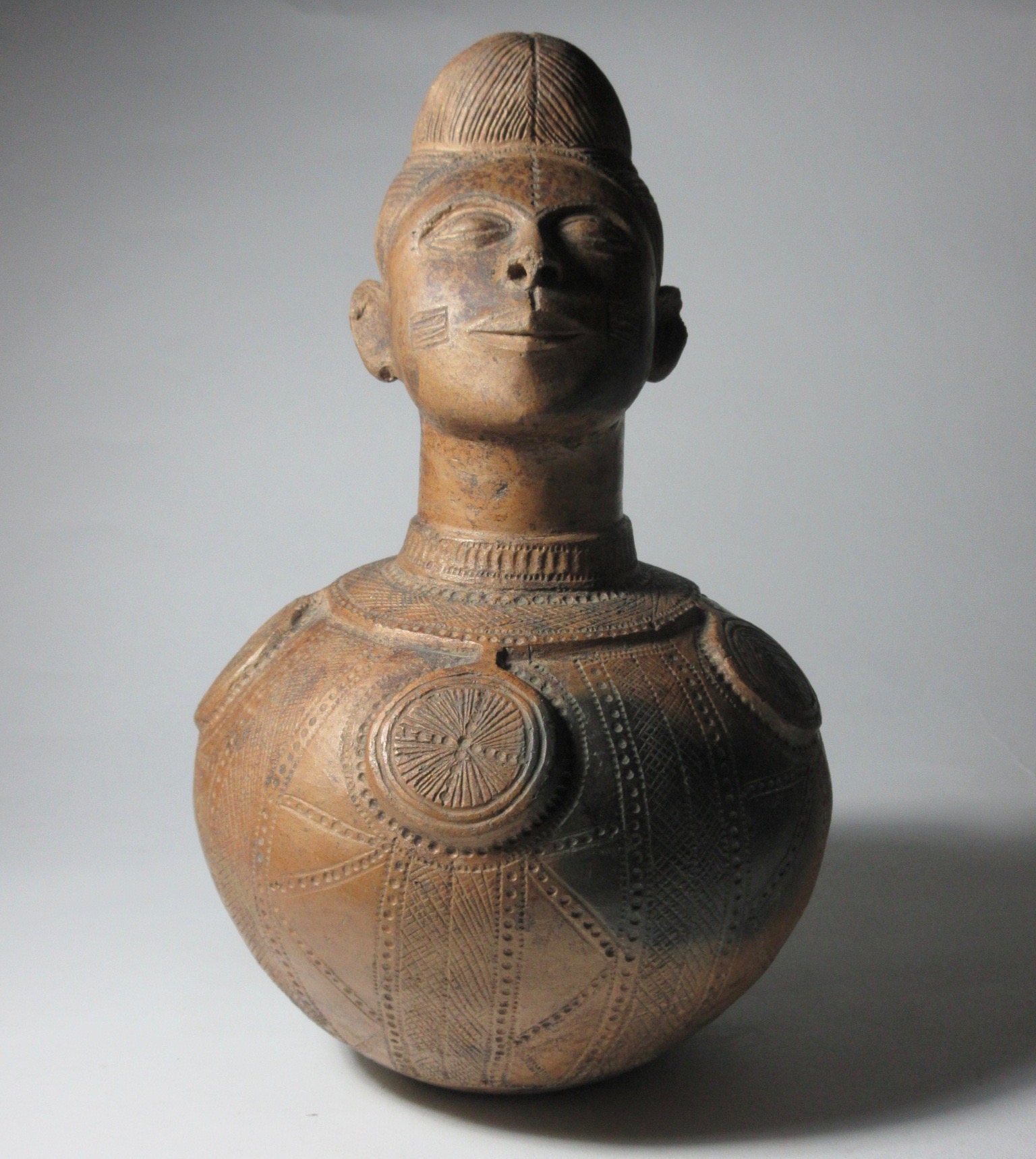
AF68
Material: earthenware with mica
Dimensions: 15 x 16 x 16cm
Provenance: Phillips Auctioneers, London; Private Collection, UK
Literature/Notes: This vessel is characteristic of works by a Zande artist known as Mbitim, typically using raw clay with tiny mica flakes to reflect light (hilidiwe). He is known to have made spherical pots with human head finials and digital bookends for Europeans. Other examples in the Pitt Rivers Museum, the Cleveland Museum, and one from the R. Rubin Collection sold in Sothebys New York 13-5-11 lot 26. Also two others in the British Museum collected in the late 1920s/early 30s, one by Mbitim from his studio in Lirangu, and another similar by an unknown potter in Tembura, published in Nigel Barley, Smashing Pots, 1994, p. 144-145.
Price: POA

Material: wood
Dimensions: 16 x 4 x 7cm
Provenance: Private Collection, UK
Literature/Notes: Jean-Baptiste Bacquart, The Tribal Arts of Africa, p. 156, fig. 4 for a similar divination implement ('friction oracle') carved with a head on squared frame. When in use, the mbuki (diviner) and client each grasp the implement and rub it back and forth on a mat together, while the diviner asks questions of the spirits. When the spirits respond, the kakishi suddenly changes to an up/down movement.
Price: £350

AF85
Material: Wood, fibre
Dimensions: 8cm
Provenance: Max Wilborg, London (collection no. 73962)
Price: £195
Enquiries, Payment, Shipping & Returns
We want to hear from you. Please request further images, condition reports, additional measurements etc. using the contact form, and we will respond directly. Please tick the GDPR compliance box if you wish to be updated about events at Ancestor Gallery in the future.
Payment is accepted by bank transfer. Once purchase has been agreed, a shipping charge will be added to the bill. After the total bill has been paid in full, your purchase will be shipped by courier within five working days to your home. Please note that shipping may be delayed if export permits are required for CITES related purchases.
Returns will be accepted within fourteen days of receipt at the purchaser’s cost to include freight, insurance, packaging. Insurance cover against loss and damage must be provided for the full cost of the item. Items must be returned in the same condition as when they were shipped, and will not be accepted if damaged or altered in any way. Refunds will only be issued once inspected and received. Any claim for items damaged in transit must be reported to us within two days of receipt with full written details and images by email.
